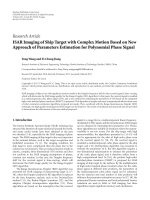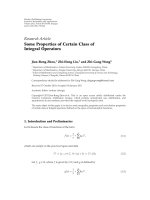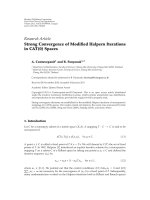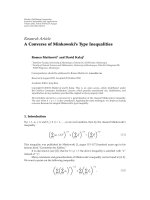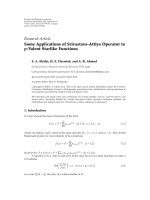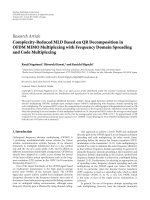Báo cáo hóa học: "Research Article Some Extensions of Banach’s Contraction Principle in Complete Cone Metric Spaces" ppt
Bạn đang xem bản rút gọn của tài liệu. Xem và tải ngay bản đầy đủ của tài liệu tại đây (513.57 KB, 11 trang )
Hindawi Publishing Corporation
Fixed Point Theory and Applications
Volume 2008, Article ID 768294, 11 pages
doi:10.1155/2008/768294
Research Article
Some Extensions of Banach’s Contraction Principle
in Complete Cone Metric Spaces
P. Raja and S. M. Vaezpour
Department of Mathematics and Computer Sciences, Amirkabir University of Technology,
P.O. Box 15914, Hafez Avenue, Tehran, Iran
Correspondence should be addressed to S. M. Vaezpour,
Received 10 December 2007; Revised 2 June 2008; Accepted 23 June 2008
Recommended by Billy Rhoades
In this paper we consider complete cone metric spaces. We generalize some definitions such as
c-nonexpansive and c, λ-uniformly locally contractive functions f-closure, c-isometric in cone
metric spaces, and certain fixed point theorems will be proved in those spaces. Among other
results, we prove some interesting applications for the fixed point theorems in cone metric spaces.
Copyright q 2008 P. Raja and S. M. Vaezpour. This is an open access article distributed under
the Creative Commons Attribution License, which permits unrestricted use, d istribution, and
reproduction in any medium, provided the original work is properly cited.
1. Introduction
The study of fixed points of functions satisfying certain contractive conditions has been at
the center of vigorous research activity, for example see 1–5 and it has a wide range of
applications in different areas such as nonlinear and adaptive control systems, parameterize
estimation problems, f ractal image decoding, computing magnetostatic fields in a nonlinear
medium, and convergence of recurrent networks, see 6–10. Recently, Huang and Zhang
generalized the concept of a metric space, replacing the set of real numbers by an ordered
Banach space and obtained some fixed point theorems for mapping satisfying different
contractive conditions 11. The study of fixed point theorems in such spaces is followed
by some other mathematicians, see 12–15. The aim of this paper is to generalize some
definitions such as c-nonexpansive and c, λ-uniformly locally contractive functions in these
spaces and by using these definitions, certain fixed point theorems will be proved.
Let E be a real Banach space. A subset P of E is called a cone if and only if the following
hold:
i P is closed, nonempty, and P
/
{0},
ii a, b ∈ R,a,b 0, and x, y ∈ P imply that ax by ∈ P,
iii x ∈ P and −x ∈ P imply that x 0.
2 Fixed Point Theory and Applications
Given a cone P ⊂ E, we define a partial ordering with respect to P by x y if and
only if y − x ∈ P . We will write x<yto indicate that x y but x
/
y, while x y will stand
for y − x ∈ int P, where int P denotes the interior of P.
The cone P is called normal if there is a number K>0 such that 0 x y implies
||x|| K||y||, for every x, y ∈ E. The least positive number satisfying above is called the
normal constant of P.
There are non-normal cones.
Example 1.1. Let E C
2
R
0, 1 with the norm ||f|| ||f||
∞
||f
||
∞
, and consider the cone
P {f ∈ E : f 0}. For each K 1, put fxx and gxx
2K
. Then, 0 g f, ||f|| 2,
and ||g|| 2K 1. Since K||f|| < ||g||, K is not normal constant of P 16.
In the following, we always suppose E is a real Banach space, P is a cone in E with
int P
/
∅,and is partial ordering with respect to P.
Let X be a nonempty set. As it has been defined in 11,afunctiond : X × X → E is
called a cone metric on X if it satisfies the following conditions:
i dx, y 0, for every x,y ∈ X,anddx, y0 if and only if x y,
ii dx, yd
y, x, for every x,y ∈ X,
iii dx, y dx, zdy, z, for every x, y, z ∈ X.
Then X, d is called a cone metric space.
Example 1.2. Let E l
1
,P {{x
n
}
n1
∈ E : x
n
0, for all n}, X, ρ a metric space, and
d : X × X → E defined by dx, y{ρx, y/2
n
}
n1
. Then X, d is a cone metric space and
the normal constant of P is equal to 1 16.
The sequence {x
n
} in X is called to be convergent to x ∈ X if for every c ∈ E with 0 c,
there is n
0
∈ N such that dx
n
,x c, for every n n
0
, and is called a Cauchy sequence if
for every c ∈ E with 0 c, there is n
0
∈ N such that dx
m
,x
n
c, for every m, n n
0
.A
cone metric space X, d is said to be a complete cone metric space if every Cauchy sequence
in X is convergent to a point of X. A self-mapT on X is said to be continuous if lim
n→∞
x
n
x
implies that lim
n→∞
Tx
n
Tx, for every sequence {x
n
} in X. The following lemmas are
useful for us to prove our main results.
Lemma 1.3 see 11, Lemma 1. Let X, d be a cone metric space, P be a normal cone with normal
constant K.Let{x
n
} be a sequence in X. Then, {x
n
} converges to x if and only if lim
n→∞
dx
n
,x0.
Lemma 1.4 see 11, Lemma 3. Let X, d be a cone metric space, {x
n
} be a sequence in X.If{x
n
}
is convergent, then it is a Cauchy sequence, too.
Lemma 1.5 see 11, Lemma 4. Let X, d be a cone metric space, P be a normal cone with
normal constant K.Let{x
n
} be a sequence in X. Then, {x
n
} is a Cauchy sequence if and only if
lim
m,n→∞
dx
m
,x
n
0.
The following example is a cone metric space, see 11.
Example 1.6. Let E R
2
,P {x, y ∈ E | x, y 0},X R,andd : X × X → E such that
dx, y|x − y|,α|x − y|, where α 0 is a constant. Then X, d is a cone metric space.
P. Raja and S. M. Vaezpour 3
2. Certain nonexpansive mappings
Definition 2.1. Let X, d be a cone metric space, where P is a cone and f : X → X is a function.
Then f is said to be c-nonexpansive, for 0 c,if
d
fx,fy
dx, y, 2.1
for every x, y ∈ X with dx, y c. If we have
d
fx,fy
<dx, y, 2.2
for every x, y ∈ X with x
/
y and dx, y c, then f is called c-contractive.
Definition 2.2. Let X, d
be a cone metric space, where P is a cone. A point y ∈ Y ⊆ X is said
to belong to the f-closure of Y andisdenotedbyy ∈ Y
f
,iffY ⊆ Y and there are a point
x ∈ Y and an increasing sequence {n
i
}⊆N such that lim
i→∞
f
n
i
xy.
Definition 2.3. Let X, d be a cone metric space, where P is a cone. A sequence {x
i
}⊆X is
said to be a c-isometric sequence if
d
x
m
,x
n
d
x
mk
,x
nk
, 2.3
for all k, m ∈ N with dx
m
,x
n
<c.Apointx ∈ X is said to generate a c-isometric sequence
under the function f : X → X,if{f
n
x} is a c-isometric sequence.
Theorem 2.4. Let X, d be a cone metric space, where P is a normal cone with normal constant K.
If f : X → X is c-nonexpansive, for some 0 c, and x ∈ X
f
, then there is an increasing sequence
{m
j
}⊆N such that lim
j→∞
f
m
j
xx.
Proof. Since x ∈ X
f
, there are y ∈ X and a sequence {n
i
} such that lim
i→∞
f
n
i
yx.If
f
m
yx, for some m ∈ N.Putm
j
n
j
− mn
j
>m, is a sequence as desired, then {m
j
} is
a sequence with desired property. Otherwise, for >0, fix δ, 0 <δ<. Choose c ∈ E with
0 c and K||c|| <δ. Then there is i ic such that
d
x, f
n
i
j
y
c
4
, 2.4
for every j ∈ N ∪{0}.Sobyc-nonexpansivity of f and putting j 0, we have
d
f
n
ik
−n
i
x,f
n
i
k
y
<
c
4
, 2.5
for every k ∈ N. Therefore,
d
f
n
i
y,f
n
ik
y
d
x, f
n
i
y
d
x, f
n
ik
y
c
2
, 2.6
for every k ∈ N. Hence,
d
x, f
n
i1
−n
i
x
d
x, f
n
i
y
d
f
n
i
y,f
n
i1
y
d
f
n
i1
y,f
n
i1
−n
i
x
<
c
4
c
2
c
4
c,
2.7
4 Fixed Point Theory and Applications
which implies
d
x, f
n
i1
−n
i
x
Kc <δ. 2.8
Put m
1
n
i1
− n
i
and suppose that m
1
<m
2
< ··· <m
j−1
chosen such that
d
x, f
m
i
y
1
2
min
m1, ,m
i−1
d
x, f
m
y
, 2.9
for i 2, 3, ,j−1. We put m
j
n
l1
−n
l
, where l is chosen so as to satisfy dx, f
lj
y c/4,
with δ replaced by
min
δ,
1
2
min
m1, ,m
i−1
d
x, f
m
y
. 2.10
It is easily seen that the sequence {m
j
} that is defined in the above satisfies the requirements
of the theorem. The proof is complete.
Theorem 2.5. Let X, d be a cone metric space, where P is a normal cone with normal constant K.
If f : X → X is a c-nonexpansive function, then every x ∈ X
f
generates a c-isometric sequence.
Proof. By contradiction, suppose that there are k,m, n ∈ N such that df
m
x,f
n
x <cand
p df
m
x,f
n
x − df
mk
x,f
nk
x
/
0. By the assumption, p ∈ P and
0 <p d
f
m
x,f
n
x
− d
f
ml
x,f
nl
x
, 2.11
for l k, l ∈ N. It means that
p K
d
f
m
x,f
n
x
− d
f
mk
x,f
nk
x
, 2.12
for l k, l ∈ N. Also by the assumption and Theorem 2.4,
lim
j→∞
f
n
j
f
l
x
lim
j→∞
f
n
j
l
xf
l
x. 2.13
Put δ p and choose c ∈ E such that 0 c and c < 1/K
2
δ.ByLemma 1.4, there is
i ∈ N such that
d
f
mn
j
x,f
m
x
c
2
,d
f
nn
j
x,f
n
x
c
2
, 2.14
for every j i. However,
d
f
m
x,f
n
x
d
f
m
x,f
mn
j
x
d
f
mn
j
x,f
nn
j
x
d
f
nn
j
x,f
n
x
c d
f
mn
j
x,f
nn
j
x
c
2
.
2.15
So
d
f
m
x,f
n
x
− d
f
mn
j
x,f
nn
j
x
c. 2.16
It means that
d
f
m
x,f
n
x
− d
f
mn
j
x,f
nn
j
x
Kc <
1
K
δ, 2.17
that is a contradiction by 2.12,forn
j
max{n
i
,k}. Therefore, p 0 and the proof is
complete.
The following corollary implies immediately.
Corollary 2.6. Let X, d be a cone metric space, where P is a normal cone with normal constant K.
If f : X → X is a nonexpansive function and x ∈ X
f
generates an isometric sequence.
P. Raja and S. M. Vaezpour 5
3. Extended contraction principle
We have the following generalized form of Banach’s contraction for cone metric spaces.
Theorem 3.1 see 11, Theorem 1. Let X, d be a complete cone metric space, P be a normal cone
with normal constant K. Suppose the mapping T : X → X satisfies the contractive condition
d
Tx,Ty
βdx, y, 3.1
for every x, y ∈ X,whereβ ∈ 0, 1 is a constant. Then T has a unique fixed point in X, and for any
x ∈ X, the sequence {T
n
x} converges to the fixed point.
It is natural to ask whether the mentioned theorem could be modified if 3.1 holds for
just sufficiently close points. To be more specific, we introduce the following definitions.
Definition 3.2. Let X, d be a cone metric space. A function f : X → X is said to be locally
contractive, if for every x ∈ X there is c ∈ X with 0 c and 0 λ<1 such that
d
fp,fq
λdp, q, 3.2
for every p, q ∈{y ∈ X : dx, y c}.Afunctionf : X → X is said to be c, λ-uniformly
locally contractive if it is locally contractive and both c and λ do not depend on x.
It is easy to find cone metric spaces which admit locally contractive which are not
globally contractive.
Example 3.3. Let E R
2
,
X
x, y | x cos t, y sin t;0 t
3π
2
⊆ R
2
, 3.3
and P {x, y ∈ E | x, y 0},andd : X × X → E such that dx, y|x − y|,α|x − y|,
where α 0 is a constant. It is easily checked that X, d is a cone metric space. Suppose that
fcos t, sin tcost/2, sint/2. It is not hard to see that f is locally contractive but not
globally contractive.
Note that every locally contractive function is c-nonexpansive for some c 0.
Definition 3.4. A cone metric space X, d is called c-chainable, for 0 c, if for every a, b ∈ X,
there is a finite set of points a x
0
,x
1
, ,x
n
b, n depends on both a and b, such that
dx
i−1
,x
i
<c,fori, 1 i n.
Example 3.5. It is easily seen that the cone metric space that is defined in Example 1.6 is c-
chainable.
Theorem 3.6. Let X, d be a complete c-chainable cone metric space, P be a normal cone with normal
constant K.Iff : X → X is c, β-uniformly locally contractive, then there is a unique point z ∈ X
such that fzz.
Proof. Let x ∈ X be arbitrary. Consider the c-chain x x
0
,x
1
, ,x
n
fx. We have
d
x, fx
n
i1
d
x
i−1
,x
i
<nc. 3.4
6 Fixed Point Theory and Applications
We have
d
f
x
i−1
,f
x
i
βd
x
i−1
,x
i
<βc, 3.5
for every 1 i n, and by induction
d
f
m
x
i−1
,f
m
x
i
<βd
f
m−1
x
i−1
,f
m−1
x
i
< ··· <β
m
c, 3.1
for every m ∈ N. Hence
d
f
m
x,f
m1
x
n
i1
d
f
m
x
i−1
,f
m
x
i
<β
m
nc, 3.2
for every m ∈ N.Now,form, p ∈ N with m<p, we have
d
f
m
x,f
p
x
p−1
im
d
f
i
x,f
i1
x
<nc
β
m
··· β
p−1
<nc
β
m
1 − β
. 3.3
It means that
d
f
m
x,f
p
x
nc
β
m
1 − β
, 3.4
for m, p ∈ N with m<p. Since k ∈ 0, 1, then lim
m,p→∞
df
m
x,f
p
x 0. So
lim
m,p→∞
df
m
x,f
p
x 0, and by Lemma 1.5, {f
m
x} is a Cauchy sequence. Since X
is complete, then lim
m→∞
f
m
xz, for some z ∈ X. From the continuity of f it follows that
fzz. To complete the proof it is enough to show that z is the unique point with this
property. To do this, suppose that there is z
∈ X such that fz
z
.Letz
x
0
,x
1
, ,x
t
z
be a c-chain. By 3.1,weobtain
d
fz,f
z
d
f
l
z,f
l
z
t
i1
d
f
l
x
i−1
,f
l
x
i
<β
l
tc. 3.5
It means that
d
z, z
d
fz,f
z
β
l
tc. 3.6
Since β ∈ 0, 1, then dz, z
0andz z
. This completes the proof.
Corollary 3.7. Let X, d be a complete c-chainable cone metric space, P be a normal cone with normal
constant K.Iff is a one to one, c, λ-uniformly locally expansive function of Y onto X,whereY ⊆ X,
then f has a unique fixed point.
Proof. It is an immediate consequence of the fact that for the inverse function all assumptions
of the Theorem 3.6 are satisfied.
In the following theorem we investigate a kind of functions which are not necessarily
contractions but have a unique fi xed point. First, we will prove the following lemma which
will be used later.
P. Raja and S. M. Vaezpour 7
Lemma 3.8. Let X, d be a complete cone metric space, P be a normal cone with normal constant K,
f : X → Xbe a continuous function, and β ∈ 0, 1 such that for every x ∈ X, there is an nx ∈ N
such that
d
f
nx
x,f
nx
y
βdx, y, 3.7
for every y ∈ X. Then for every x ∈ X, rxsup
n
df
nx
x,x is finite.
Proof. Let x ∈ X and lxmax{df
j
x,x : j 1, 2, ,nx}.Ifn ∈ N and n>nx, then
there is s ∈ N ∪{0} such that snx <n s 1nx and we have
d
f
n
x,x
d
f
nx
f
n−nx
x
,f
nx
x
d
f
nx
x,x
βd
f
n−nx
x,x
d
f
nx
x,x
d
f
nx
x,x
β
d
f
n−nx
x,f
nx
x
d
f
nx
x,x
d
f
nx
x,x
β
βd
f
n−2nx
x,x
d
f
nx
x,x
··· d
f
nx
x,x
1 β β
2
··· β
s
.
3.8
It means that
d
f
n
x,x
K
1
1 − β
d
f
nx
x,x
K
1
1 − β
lx. 3.9
Hence rx is finite and the proof is complete.
Theorem 3.9. Let X, d be a complete cone metric space, P be a normal c one with normal constant
K, β ∈ 0, 1, and f : X → X be a continuous function such that for every x ∈ X, there is an
nx ∈ N such that
d
f
nx
x,f
nx
y
βdx, y, 3.10
for every y ∈ X.Thenf has a unique fixed point u ∈ X and lim
n→∞
f
n
x
0
u, for every x
0
∈ X.
Proof. Let x
0
∈ X be arbitrary, and m
0
nx
0
. Define the sequence x
1
f
m
0
x
0
,x
i1
f
m
i
x
i
, where m
i
nx
i
. We show that {x
n
} is a Cauchy sequence. We have
d
x
n1
,x
n
d
f
m
n−1
f
m
n
x
n−1
,f
m
n−1
x
n−1
βd
f
m
n
x
n−1
,x
n−1
··· β
n
d
f
m
n
x
0
,x
0
,
3.11
for every n ∈ N.SobyLemma 3.8, dx
n1
,x
n
Kβ
n
rx
0
, for every n ∈ N. Now, suppose
that m, n ∈ N with m<n, we have
d
x
n
,x
m
K
n−1
im
d
x
i1
,x
i
K
β
n
1 − β
r
x
0
. 3.12
Since lim
n→∞
β
n
/1 − β 0, then lim
m,n→∞
dx
n
,x
m
0, and by Lemma 1.5, {x
n
} is a
Cauchy sequence. Completeness of X implies that lim
n→∞
x
n
u, for some u ∈ X.Now,we
8 Fixed Point Theory and Applications
show that fuu. By contradiction, suppose that fu
/
u. We claim that there are c, d ∈ E
such that 0 c, 0 d and B
c
u and B
d
fuhave no intersection, where B
e
x{y ∈ X :
dx, y e}, for every x ∈ X and 0 e. If not, then suppose that >0, and choose c ∈ E
with 0 c and Kc <. Then clearly, 0 c/2andforz ∈ B
c/2
u ∩ B
c/2
fu, we have
d
u, fu
du, zd
z, fu
c. 3.13
It means that du, fu≤Kc <. Since >0 is arbitrary, then du, fu 0andso
fuu, a contradiction. Therefore, assume that c, d ∈ E with 0 c, 0 d are such that
B
c
u ∩ B
d
fu ∅. Since f is continuous, then there is n
0
∈ N such that x
n
∈ B
c
u and
fx
n
∈ B
d
fu, for every n ∈ N and n n
0
. Then
d
f
x
n
,x
n
d
f
m
n−1
f
x
n−1
,f
m
n−1
x
n−1
≤ βd
f
x
n−1
,x
n−1
··· β
n
d
f
x
0
,x
0
,
3.14
for every n ∈ N. It means that dfx
n
,x
n
Kβ
n
dfx
0
,x
0
, for every n ∈ N.So
lim
n→∞
dfx
n
,x
n
0, a contradiction. Thus fuu. The uniqueness of the fixed point
follows immediately from the hypothesis.
Now, suppose that x
0
∈ X is arbitrary. To show that lim
n→∞
f
n
x
0
u,set
r
0
max
d
f
m
x
0
,u
: m 0, 1, ,nu − 1
. 3.15
If n is sufficiently large, then n rnuq,forr>0and0 q<nu, and we have
d
f
n
x
0
,u
d
f
rnuq
x
0
,f
nu
u
βd
f
r−1nuq
x
0
,u
≤··· β
r
d
f
q
x
0
,u
.
3.16
It means that
d
f
n
x
0
,u
Kβ
r
d
f
q
x
0
,u
Kβ
r
r
0
. 3.17
Therefore, lim
n→∞
df
n
x
0
,u 0 and hence lim
n→∞
f
n
x
0
u. This completes the proof.
Definition 3.10. Let X be an ordered space. A function ϕ : X → X is said to be a comparison
function if for every x, y ∈ X, x y, implies that ϕx ϕy,ϕx x,and
lim
n→∞
||ϕ
n
x|| 0, for every x ∈ X.
Example 3.11. Let E R
2
,P {x, y ∈ E | x, y 0}. It is easy to check that ϕ : E → E,
with ϕx, yax, ay, for some a ∈ 0, 1 is a comparison function. Also if ϕ
1
,ϕ
2
are two
comparison functions over R, then ϕx, yϕ
1
x,ϕ
2
y is also a comparison function
over E.
Recall that for a cone metric space X, d, where P is a cone with normal constant K,
since for every x ∈ X, x x, and therefore x Kx, then K 1.
Theorem 3.12. Let X, d be a complete c one metric space, where P is a normal cone with normal
constant K.Letf : X → X be a function such that there exists a comparison function ϕ : P → P
such that
d
fx,fy
ϕ
dx, y
, 3.18
for every x, y ∈ X.Thenf has a unique fixed point.
P. Raja and S. M. Vaezpour 9
Proof. Let x
0
∈ X be arbitrary. We have
d
f
n
x
0
,f
n1
x
0
ϕ
d
f
n−1
x
0
,f
n
x
0
ϕ
2
df
n−2
x
0
,f
n−1
x
0
··· ϕ
n
d
x
0
,f
x
0
,
3.19
for every n ∈ N. Since lim
n→∞
ϕ
n
dx
0
,fx
0
0, for an arbitrary >0, we can choose
n ∈ N such that
d
f
n
x
0
,f
n1
x
0
<
− K
ϕc
K
, 3.20
for every n ≥ n
0
and c ∈ P with
c <
K
2
,
1
K
ϕc
ϕ
d
f
n
x
0
,f
n1
x
0
. 3.21
For n ≥ n
0
, we have
d
f
n
x
0
,f
n2
x
0
d
f
n
x
0
,f
n1
x
0
d
f
n1
x
0
,f
n2
x
0
. 3.22
So
d
f
n
x
0
,f
n2
x
0
K
d
f
n
x
0
,f
n1
x
0
K
d
f
n1
x
0
,f
n2
x
0
<K
− K
ϕc
K
K
2
ϕ
d
f
n
x
0
,f
n1
x
0
.
3.23
Now, for every n n
0
, we have
d
f
n
x
0
,f
n3
x
0
d
f
n
x
0
,f
n1
x
0
d
f
n1
x
0
,f
n3
x
0
. 3.24
Since K ≥ 1, then we have
d
f
n
x
0
,f
n3
x
0
K
d
f
n
x
0
,f
n1
x
0
K
d
f
n1
x
0
,f
n3
x
0
<K
− K
ϕc
K
K
2
ϕ
d
f
n
x
0
,f
n2
x
0
.
3.25
By induction, we have df
n
x
0
,f
nr
x
0
<, for every r ∈ N and n n
0
. Hence by
Lemma 1.5, we have {f
n
x
0
} is a Cauchy sequence in X, d. So lim
n→∞
f
n
x
0
x
∗
, for some
x
∗
∈ X. Now, we will prove fx
∗
x
∗
. Since lim
n→∞
f
n
x
0
x
∗
, for every c 0, there exists
n
c
∈ N such that for every n n
c
, we have df
n
x
0
,x
∗
<c. Therefore,
d
x
∗
,f
x
∗
d
x
∗
,f
n1
x
0
d
f
f
n
x
0
,f
x
∗
d
x
∗
,f
n1
x
0
ϕ
d
f
n
x
0
,x
∗
<d
x
∗
,f
n1
x
0
d
f
n
x
0
,x
∗
< 2c,
3.26
for every c 0. So fx
∗
x
∗
. For the uniqueness of the fixed point, suppose that there exists
y
∗
∈ X such that fy
∗
y
∗
. Hence
d
x
∗
,y
∗
d
f
n
x
∗
,f
n
y
∗
ϕ
n
d
y
∗
,x
∗
. 3.27
So
d
x
∗
,y
∗
K
ϕ
n
d
y
∗
,x
∗
. 3.28
Since lim
n→∞
ϕ
n
dy
∗
,x
∗
0, then x
∗
y
∗
and the proof is complete.
10 Fixed Point Theory and Applications
4. Applications
Theorem 4.1. Consider the integral equation
xt
b
a
k
t, s, xs
ds gt,t∈ a, b. i
Suppose that
i k : a, b × a, b × R
n
→ R
n
and g : a, b → R
n
;
ii kt, s, · : R
n
→ R
n
is increasing for every t, s ∈ a, b;
iii there exists a continuous function p : a, b × a, b → R
and a comparison function
ϕ : R
2
→ R
2
such that
kt, s, u − kt, s, v
,α
kt, s, u − kt, s, v
pt, s,αpt, s
ϕ
du, v
, 4.1
for every t, s ∈ a, b,u,v∈ R
n
;
iv sup
t∈a,b
b
a
pt, s,αpt, sds 1.
Then the integral equation i has a unique solution x
∗
in Ca, b, R
n
.
Proof. Let X Ca, b, R
n
,P {x, y : x, y 0}⊆R
2
,anddefinedf, gf −g
∞
,αf −
g
∞
, for every f, g ∈ X. Then it is easily seen that X, d is a cone metric space. Define
A : Ca, b, R
n
→ Ca, b, R
n
,by
Axt :
b
a
k
t, s, xs
ds gt,t∈ a, b. 4.2
For every x, y ∈ X, we have
Axt − Ayt
,α
Axt − Ayt
b
a
k
t, s, xs
− k
t, s, ys
ds
,α
b
a
k
t, s, xs
− k
t, s, ys
ds
b
a
k
t, s, xs
− k
t, s, ys
ds,
b
a
α
kt, s, xs − k
t, s, ys
ds
b
a
pt, s,αpt, s
ϕ
xs − ys
,α
xs − ys
ds
ϕ
x − y
∞
,αx − y
∞
b
a
pt, s,αpt, s
ds
ϕ
x − y
∞
,αx − y
∞
.
4.3
Hence dAx, Ay ϕdx, y, for every x, y ∈ X. The conclusion follows now from
Theorem 3.12.
P. Raja and S. M. Vaezpour 11
References
1 M. Edelstein, “An extension of Banach’s contraction principle,” Proceedings of the American
Mathematical Society, vol. 12, no. 1, pp. 7–10, 1961.
2 M. Edelstein, “On nonexpansive mappings,” Proceedings of the American Mathematical Society, vol. 15,
no. 5, pp. 689–695, 1964.
3 T. Gnana Bhaskar and V. Lakshmikantham, “Fixed point theorems in partially ordered metric spaces
and applications,” Nonlinear Analysis: Theory, Methods & Applications, vol. 65, no. 7, pp. 1379–1393,
2006.
4 B. E. Rhoades, “A comparison of various definitions of contractive mappings,” Transactions of the
American Mathematical Society, vol. 226, pp. 257–290, 1977.
5 V. M. Sehgal, “A fixed point theorem for mappings with a contractive iterate,” Proceedings of the
American Mathematical Society, vol. 23, no. 3, pp. 631–634, 1969.
6 K. Leibovic, “The principle of contraction mapping in nonlinear and adaptive control systems,” IEEE
Transactions on Automatic Control, vol. 9, no. 4, pp. 393–398, 1964.
7 G. A. Medrano-Cerda, “A fixed point formulation to parameter estimation problems,” in Proceedings
of the 26th IEEE Conference on Decision and Control (CDC ’87), vol. 26, pp. 1914–1915, Los Angeles, Calif,
USA, December 1987.
8 Y M. He and H J. Wang, “Fractal image decoding based on extended fixed-point theorem,” in
Proceedings of the International Conference on Machine Learning and Cybernetics (ICMLC ’06), pp. 4160–
4163, Dalian, China, August 2006.
9 W. Rakowski, “The fixed point theorem in computing magnetostatic fields in a nonlinear medium,”
IEEE Transactions on Magnetics, vol. 18, no. 2, pp. 391–392, 1982.
10 J. E. Steck, “Convergence of recurrent networks as contraction mappings,” in Proceedings of the
International Joint Conference on Neural Networks (IJCNN ’92), vol. 3, pp. 462–467, Baltimore, Md, USA,
June 1992.
11 L G. Huang and X. Zhang, “Cone metric spaces and fixed point theorems of contractive mappings,”
Journal of Mathematical Analysis and Applications, vol. 332, no. 2, pp. 1468–1476, 2007.
12 M. Abbas and G. Jungck, “Common fixed point results for noncommuting mappings without
continuity in cone metric spaces,” Journal of Mathematical Analysis and Applications, vol. 341, no. 1,
pp. 416–420, 2008.
13 D. Ili
´
candV.Rako
ˇ
cevi
´
c, “Common fixed points for maps on cone metric space,” Journal of
Mathematical Analysis and Applications, vol. 341, no. 2, pp. 876–882, 2008.
14
P. Raja and S. M. Vaezpour, “Some fixed point theorems in complete cone metric spaces,” submitted.
15 P. Raja and S. M. Vaezpour, “Fixed point theorems for certain contractive mappings in complete cone
metric spaces,” submitted.
16 Sh. Rezapour and R. Hamlbarani, “Some notes on the paper “Cone metric spaces and fixed point
theorems of contractive mappings”,” Journal of Mathematical Analysis and Applications, vol. 345, no. 2,
pp. 719–724, 2008.

